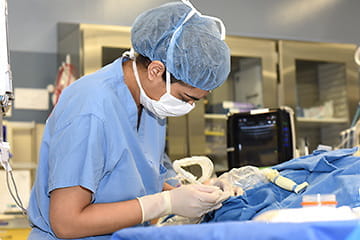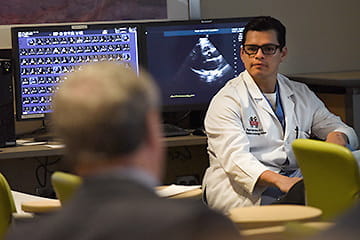Anesthesiology residency clinical rotations enhance the overall clinical skills of analysis, synthesis and evaluation of anesthesiology principles and practice. During the CA-1 rotations in clinical anesthesia, emphasis is on the foundational aspects of patient care, medical knowledge and the application of anesthetic principles. The medical knowledge portion of the CA-2 and CA-3 year provides anesthesiology residents the ability to hone understanding of their foundational skills.
All residents who complete anesthesiology training at Indiana University School of Medicine are expected to become board-certified anesthesiologists. The broad overview of clinical experiences that are provided prepares residents to obtain mastery within the various subspecialties of anesthesiology.
Subspecialty Rotations
The majority of subspecialty rotations are spread out between the CA-2 and CA-3 year, while a few may be completed during the CA-1 year. Schedules can be adjusted for those with specific fellowship interests.
Anesthesia residents typically spend one or two four-week rotations on Chronic Pain, Non-OR Anesthesia, Perioperative Care Unit/PACU, Surgical ICU, Thoracic, and Transplant Anesthesia. Residents in this program spend two or three rotations in Acute Perioperative Pain, Cardiovascular Anesthesia, Neurosurgical Anesthesia, and Obstetrical Anesthesia. Four to six rotations forcus on Pediatric Anesthesiology.
CA-1 Year
The CA-1 resident year emphasizes the principles of general anesthesiology necessary to function as an anesthesiologist. Residents are exposed to a myriad of surgical cases including general surgery, otolaryngology, urology, orthopedics, gynecology, and pediatrics. Both regional and general anesthesia techniques are utilized. The first half of the year is dedicated to general OR cases. The second half of the year allows residents to start subspecialty rotations, especially those with an interest in pursuing a fellowship.
CA-2 Year
During the CA-2 year, residents develop greater mastery and knowledge of the skills learned during the CA-1 year. In addition, the CA-2 year incorporates rotations in the subspecialties of anesthesiology, including obstetric, cardiovascular and neurosurgical anesthesiology, critical care medicine, and chronic pain medicine. Residents also gain additional experience in pediatric anesthesiology.
Each clinical rotation includes an organized didactic program to ensure residents become clinically proficient and knowledgeable about the fundamentals of each subspecialty. Residents are afforded simulation training in this year and have clinical experiences to master cardiopulmonary resuscitation and develop skills to manage complex surgical cases, including those involving deliberate hypotension, deep hypothermic arrest, major vascular procedures and organ transplantation.
CA-3 Year
The CA-3 year is designed to provide the clinical experience and education necessary for the resident to become a perioperative physician and anesthesia consultant. Advanced training occurs in pain management as well as in cardiovascular, transplant, vascular, obstetric, pediatric, thoracic, neurosurgical and ambulatory anesthesiology.


